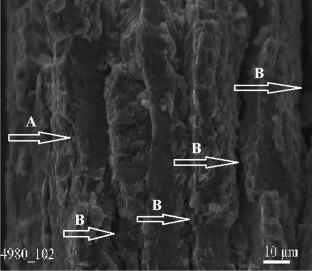Powder Metallurgy and Metal Ceramics ( IF 1 ) Pub Date : 2023-08-15 , DOI: 10.1007/s11106-023-00360-x Yu. F. Lugovskoy , V. A. Nazarenko , V. A. Zorin , S. A. Spiridonov , V. G. Borovik

|
The paper examines three microlayer Ti/TiAl3 materials of initial Ti–Al composition, which were produced through reactive sintering and rolling of packets consisting of alternating titanium and aluminum ribbons of varying thickness at 600, 700, and 770°C. Young’s modulus of these materials was determined under longitudinal vibrations at room temperature with a frequency of about 45 kHz and under resonant bending vibrations at high temperatures ranging from 20 to 820°C with a frequency a hundred times lower. The temperature dependences of the elastic modulus E for the microlayer materials exhibited slopes between those of the dependences for titanium and the well- known VT25U alloy. The Ti/TiAl3 materials were heated and held at 700°C to result in a material with stable E values, surpassing those of the VT25U alloy at temperatures up to 700°C. The dependences of stresses in the samples on the relative power of the test installation were determined at constant temperatures of 650 and 700°C for the microlayer Ti/TiAl3 and VT25U materials. The microlayer materials dissipated a significantly larger portion of mechanical vibration energy than the heat-resistant VT25U material. The difference in the fatigue resistance mechanisms for the microlayer and isotropic materials at high temperatures is not solely attributed to their distinct temperature dependences of Young’s modulus at atomic interaction levels. The difference primarily arises from the variation in temperature-dependent cyclic strains associated with dislocations at microstructural and macrostructural levels. A fatigue crack is shown to delaminate the material in the middle of the intermetallic layers.
中文翻译:

循环加载下微层 Ti/TiAl3 复合材料力学性能的温度依赖性
本文研究了三种初始 Ti-Al 成分的微层 Ti/TiAl 3材料,这些材料是通过在 600、700 和 770°C 下反应烧结和轧制由不同厚度的交替钛和铝带组成的包而生产的。这些材料的杨氏模量是在室温下频率约为 45 kHz 的纵向振动和在 20 至 820°C 高温下频率低一百倍的共振弯曲振动下测定的。微层材料的弹性模量 E 的温度依赖性表现出介于钛和众所周知的 VT25U 合金之间的斜率。钛/钛铝3将材料加热并保持在 700°C 下,形成具有稳定 E 值的材料,在高达 700°C 的温度下超过了 VT25U 合金。对于微层 Ti/TiAl 3,在 650 和 700°C 的恒定温度下确定了样品中应力对测试装置相对功率的依赖性和VT25U材料。与耐热 VT25U 材料相比,微层材料耗散的机械振动能量明显更大。微层材料和各向同性材料在高温下的抗疲劳机制的差异不仅仅归因于它们在原子相互作用水平上杨氏模量的独特温度依赖性。这种差异主要源于与微观结构和宏观结构水平上的位错相关的温度依赖性循环应变的变化。显示疲劳裂纹使金属间化合物层中间的材料分层。



























 京公网安备 11010802027423号
京公网安备 11010802027423号